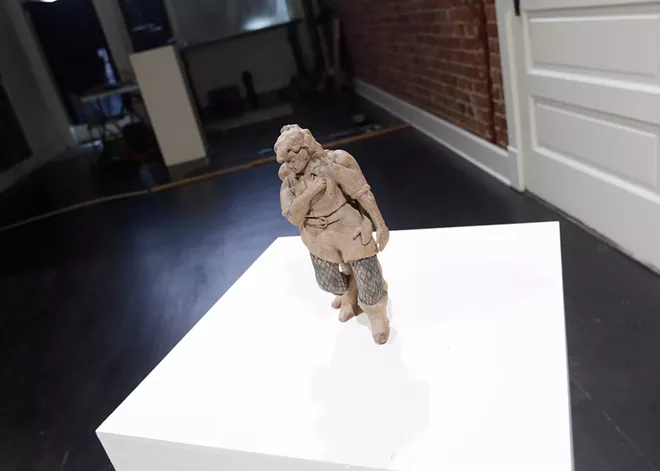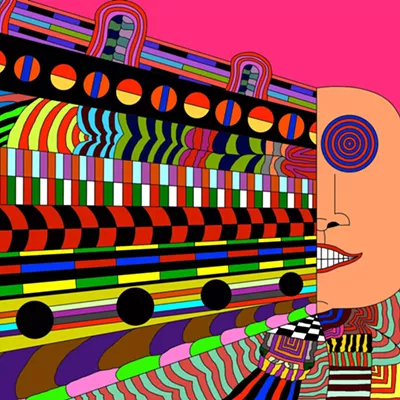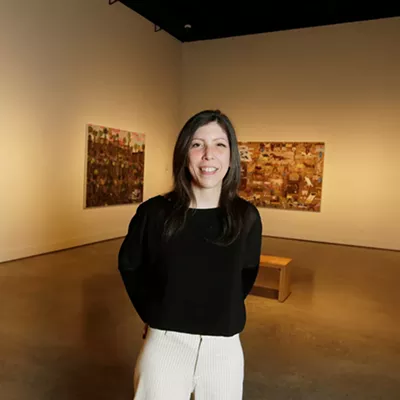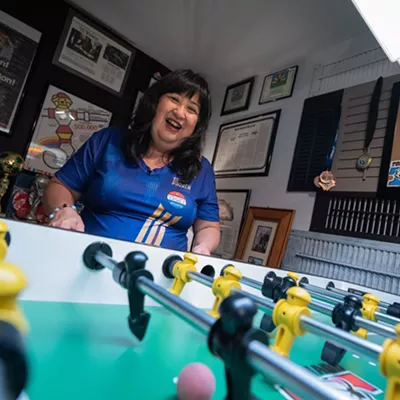Images of nude women project onto a white screen at the front of Saranac Art Projects' East Gallery. Abigail Hansel uses a soundboard to produce dissonant and often eerie noises as a handsaw occasionally sounds off while June T. Sanders creates a wood sculpture. Both artists' creations showcase how two trans women respond to these images portraying women in stereotypically erotic poses.
After an hour, the audience leaves and the sculpture Sanders created, "the residue of the performance," stays at the gallery as its own art installation. It's an abstract message about what exists beyond the bodily representations of gender — genitalia, body shape, face structure, hair length — that we're familiar with.
"I've had shows in the past that are very trans-oriented, like this show, but I don't use that language in the shows," Sanders explains. "That's not because I'm trying to hide what it is, but because I'm trying to see what still exists when we remove that language."
Sanders, an assistant professor in the digital technology and culture program at Washington State University, curated the live performance on June 6 to launch her monthlong show "An Infinite Gesture" at Saranac Art Projects.
There are only four pieces of art in the show. Besides Sanders' and Hansel's "residue," there's a large grayscale photograph of a blurry landscape and building by Leor Miller, a small ceramic statue depicting two intertwined dancers by Elva Bennett, and an abstract multimedia piece by Eman Ahmed titled "Men 3enaya Elithnen."
"The Dancers represent an ease of intimacy in trans friendships and the resistance to categorization that intimacy springs from," Bennett says via text. "As a figurative sculptor, I am most interested in weighty, unspoken moments when unsayable things are conveyed with our whole bodies."
While that may seem like a small showing for a monthlong exhibit, Sanders says that sparsity is intentional. In a crowded gallery viewers are more inclined to make snap judgments about the art, but Sanders argues that viewing art in a sparse or solitary space allows attendees to think more deeply about the work in front of them.
"We are always quick to form opinions and judgments about art in the same way that we do about other people's bodies," she explains. "What I want this show to do is ask people to strive more for understanding."
Part of that understanding, she continues, requires humans to trudge through the uncomfortability that forming a community requires so as to find some common ground.
"People are really scared about getting something wrong, and people are also really scared about being misread at the same time. Trying to figure out how we're going to relate to each other, looks different if we give each other the space and time to do that, and we become less reactionary because of it."

Sanders sees "An Infinite Gesture" as a departure from the artistic tropes of queer representation — the androgynous portraits, the glitter and rainbows, the hormone vials and needles — that are often expected of queer artists.
"It's hard because that art is what gets rewarded," Sanders says. "I think we do see gender as this very porous and socially created thing, but I also think, especially in the age of heightened representation, we also see it in a very small way."
Sanders' Saranac show envisions new ways of seeing and creating trans forms that aren't meant to be explicit to those who aren't queer. It's an intentional statement that art concerned with nontraditional genders and sexualities does not need to be understandable or even legible for cisgender and straight people.
The thought, she says, is inspired by American theorist and poet Fred Moten's The Undercommons, which explores the underground connections between marginalized communities that allow them to gesture toward each other openly, but to communicate privately.
"That's why the show is called 'An Infinite Gesture,' because it's asking 'How do we gesture towards each other outside of visibility?' Abstraction is one of those ways that we can do that," Sanders explains. "It's like, how do we communicate while other people are listening? How do we communicate with each other during the fear of violence, where we don't know if rights are going to come back, or we don't know if being out and open and visible is going to provide more safety or more harm?"
Finding ways to communicate and think deeply about gender means pushing past visibility just for visibility's sake. "An Infinite Gesture" asks its viewers a lot of questions in search of more thoughtful communication about gender, but answers aren't likely to be found.
"We've known for a bit that visibility can be sort of a trap. We know that visibility isn't freedom, it's not liberation, and visibility often can cause danger," Sanders says. "I don't know if art should be trying to provide answers for things, but I think the questions we're posing are like, 'How do we think about gender?' and 'How do we think about transsexuality, beyond bodily representations of that?'"
Pushing past obvious, outward notions of queerness allows Sanders to explore those identities in an abstract way.
"When you're first trying to figure things out with your own gender or expression, or even just sexuality, I think we look at very concrete things to use as references," Sanders says. "Once you get past that, you start to look at more abstract things, or less human things, as these representations of what you're trying to find. So if we're looking at something like a bench, we can think of what the trans version of that bench might look like, or what it might do, or what it might not do, and I think that's when things start to get really interesting." ♦
June T. Sanders: An Infinite Gesture • Through June 28, open Fri-Sat from 12-8 pm • Free • Saranac Art Projects • 25 W. Main Ave. • sapgallery.com
























